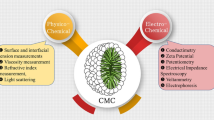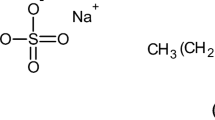Abstract
The effect of gemini (16-s-16, s = 4, 5, 6) surfactants on the reaction rate of ninhydrin with [Cu(II)-Gly-Tyr]+ complex was determined using a spectrophotometric technique. The ninhydrin concentration was kept in excess in order to maintain pseudo-first-order conditions. The reaction followed irreversible first- and fractional-order kinetics with respect to [Cu(II)-Gly-Tyr]+ and [ninhydrin], respectively. It is found that gemini surfactants effectively catalyze the reaction. The rate constants (k ψ) first increase and then become relatively constant with increasing gemini surfactant concentration similar to conventional cetyltrimethylammonium bromide. At higher gemini surfactant concentration a third region of increasing k ψ is observed. The unusual third region is ascribed to changes in micellar morphology. The kinetic data has been analyzed using a micellar pseudo-phase model.






Similar content being viewed by others
References
Davey TW, Ducker WA, Hayman AR (2000) Aggregation of ω-hydroxy quaternary ammonium bolaform surfactants. Langmuir 16:2430–2435
Zana R (2002) Dimeric and oligomeric surfactants. Behavior at interfaces and in aqueous solution: a review. Adv Colloid Interface Sci 97:205–253
Rosen MJ (2004) Surfactants and interfacial phenomena, 3rd edn. Wiley, New York
Choi TS, Shimizu Y, Shirai H, Hamada K (2000) Solubilization of disperse dyes in cationic gemini surfactant micelles. Dyes Pigments 45:145–152
Camilleri P, Kremer A, Edwards AJ, Jennings KH, Jenkins O, Marshall I, McGregor C, Neville W, Rice SQ, Smith RJ, Wilkinson MJ, Kirby AJ (2000) A novel class of cationic gemini surfactants showing efficient in vitro gene transfection properties. Chem Commun 1253–1254. doi:10.1039/B001742F
Voort PVD, Mathieu M, Mees F, Vansant EF (1998) Synthesis of high-quality mcm-48 and mcm-41 by means of the gemini surfactant method. J Phys Chem B 102:8847–8851
Chen K, Locke DC, Maldacker T, Lin JL, Aawasiripong S, Schurrath U (1998) Separation of ergot alkaloids by micellar electrokinetic capillary chromatography using cationic gemini surfactants. J Chromatogr A 822:281–290
Dreja M, Tieke B (1998) Polymerization of styrene in ternary microemulsion using cationic gemini surfactants. Langmuir 14:800–807
Li F, Rosen MJ (2000) Adsorption of gemini and conventional cationic surfactants onto montmorillonite and the removal of some pollutants by the clay. J Colloid Interface Sci 224:265–271
Pavlikova M, Lacko I, Devinsky F, Mlynarcik D (1995) Quantitative relationships between structure, aggregation properties and antimicrobial activity of quaternary ammonium bola amphiphiles. Collect Czech Chem Commun 60:1213–1228
Friedman F (2004) Applications of the ninhydrin reaction for analysis of amino acids, peptides, and proteins to agricultural and biomedical sciences. J Agric Food Chem 52:385–406
Connell GC, Dixon GH, Hanes CS (1955) Quantitative chromatographic methods for the study of enzymic transpeptidation reactions. Can J Biochem Physiol 33:416–427
Kalyankar GD, Snell EE (1957) Differentiation of α-amino-acids and amines by non-enzymatic transamination on paper chromatograms. Nature 180:1069–1070
Joullie MM, Thompson TR, Nemeroff NH (1991) Ninhydrin and ninhydrin analogs. Syntheses and applications. Tetrahedron 47:8791–8830
Kabir-ud-Din, Salem JKJ, Kumar S, Khan Z (2000) Effect of cationic surfactants on the addition-elimination type interaction between aspartic acid and ninhydrin. Colloids Surf A 168:241–250
Kabir-ud-Din, Akram M, Rafiquee MZA, Khan Z (2001) Micellar and salt effects on the rate of the condensation between ninhydrin and [Cr(his)(H2O)3]2+. Colloids Surf A 178:167–176
Khan IA, Bano M, Kabir-ud-Din (2010) Micellar and solvent effects on the rate of reaction between l-tyrosine and ninhydrin. J Disp Sci Technol 31:177–182
Kumar D, Neo K-E, Rub MA, Tan ZL, Beh WL, Wong HL (2015) Interaction of metal-dipeptide complex with ninhydrin in the absence and presence of conventional CTAB surfactant. J Disp Sci Technol 36:1657–1664
Kumar D, Rub MA, Akram M, Kabir-ud-Din (2014) Effect of gemini [alkanediyl-α,ω-bis(dimethylcetylammonium bromide)] (16-s-16, s = 4, 5, 6) surfactants on the interaction of ninhydrin with chromium-glycylphenylalanine. Spectrochim Acta A 132:288–294
Akram M, Kumar D, Kabir-ud-Din (2013) Influence of cationic gemini and conventional CTAB on the interaction of [Cr(III)-Gly-Tyr]2+ complex with ninhydrin. Colloids Surf A 428:92–99
Kumar D, Rub MA, Akram M, Kabir-ud-Din (2014) Interaction of chromium(III) complex of glycylphenylalanine with ninhydrin in aqueous and cetyltrimethylammonium bromide (CTAB) micellar media. Tenside Surf Deterg 51:157–163
Britton HTS (1942) Hydrogen ions, vol 1. Chapman and Hall, London
Zana R, Benrraou M, Rueff R (1991) Alkanediyl-.α,ω-bis(dimethylalkylammonium bromide) surfactants. 1. Effect of the spacer chain length on the critical micelle concentration and micelle ionization degree. Langmuir 7:1072–1075
Roberts JD, Caserio MC (1992) Basic principles of organic chemistry, 2nd edn. WA Benjamin Inc, California
Broxton TJ, Wright S (1986) Micellar catalysis of organic reactions. 18. Basic hydrolysis of diazepam and some N-alkyl derivatives of nitrazepam. J Org Chem 51:2965–2969
Menger FM, Portnoy CE (1967) Chemistry of reactions proceeding inside molecular aggregates. J Am Chem Soc 89:4698–4703
Bunton CA (1979) Reaction kinetics in aqueous surfactant solutions. Catal Rev-Sci Eng 20:1–56
Romsted LS (1977) A General Kinetic Theory of Rate Enhancements for Reactions between Organic Substrates and Hydrophilic Ions in Micellar Systems. In: Mittal KL (ed) Micellization, solubilization and microemulsions, vol 2. Plenum, New York, p. 509
Cerichelli G, Mancini G, Luchetti G, Savelli G, Bunton CA (1994) Surfactant effects upon cyclization of o-(.omega.-haloalkoxy)phenoxide ions. The role of premicellar assemblies. Langmuir 10:3982–3987
Bunton CA, Nome F, Quina FH, Romsted LS (1991) Ion binding and reactivity at charged aqueous interfaces. Acc Chem Res 24:357–364
Bacaloglu R, Bunton CA (1992) Surfactant effects upon nucleophilic aromatic substitution: observation of double rate maxima. J Colloid Interface Sci 153:140–151
Marconi DMO, Frescura VLA, Zanette D, Nome F, Bunton CA (1994) Nucleophilically assisted deacylation in sodium dodecanoate and dodecyl sulfate micelles. Quantitative evidence on premicellar complexes. J Phys Chem 98:12415–12419
Brinchi L, Germani R, Gorracci L, Savelli G, Bunton CA (2002) Decarboxylation and dephosphorylation in new gemini surfactants. Changes in aggregate structures. Langmuir 18:7821–7825
Kabir-ud-Din, Siddiqui US (2010) Catalytic role of gemini surfactant micelles in the ninhydrin–l-isoleucine reaction. Colloid J 72:14–22
Kabir-ud-Din, Fatma W, Khan ZA, Dar AA (2007) 1H NMR and viscometric studies on cationic gemini surfactants in presence of aromatic acids and salts. J Phys Chem B 111:8860–8867
Friedman M (1967) Solvent effects in reactions of amino groups in amino acids, peptides, and proteins with alpha,beta-unsaturated compounds. J Am Chem Soc 89:4709–4713
Rub MA, Kumar D, Azum N, Khan F, Asiri AM (2014) Study of the interaction between promazine hydrochloride and surfactant (conventional/gemini) mixtures at different temperatures. J Sol Chem 43:930–949
Rub MA, Azum N, Kumar D, Asiri AM, Marwani HM (2014) Micellization and microstructural studies between amphiphilic drug ibuprofen with non-ionic surfactant in aqueous urea solution. J Chem Thermodyn 74:91–102
Rub MA, Asiri AM, Sheikh MS, Azum N, Khan A, Khan AAP, Rahman MM, Kabir-ud-Din (2014) Aggregation and phase separation phenomenon of amitriptyline hydrochloride under the influence of pharmaceutical excipients. J Surf Deterg 17:37–48
Acknowledgments
The authors acknowledge the Universiti Tunku Abdul Rahman Research Fund (UTARRF), Malaysia for providing financial assistance through the research project no. IPSR/RMC/UTARRF/2014-C2/N02.
Author information
Authors and Affiliations
Corresponding author
About this article
Cite this article
Kumar, D., Neo, KE. & Rub, M.A. Effect of Alkanediyl-α,ω-Type Cationic Dimeric (Gemini) Surfactants on the Reaction Rate of Ninhydrin with [Cu(II)-Gly-Tyr]+ Complex. J Surfact Deterg 19, 101–109 (2016). https://doi.org/10.1007/s11743-015-1754-y
Received:
Accepted:
Published:
Issue Date:
DOI: https://doi.org/10.1007/s11743-015-1754-y




